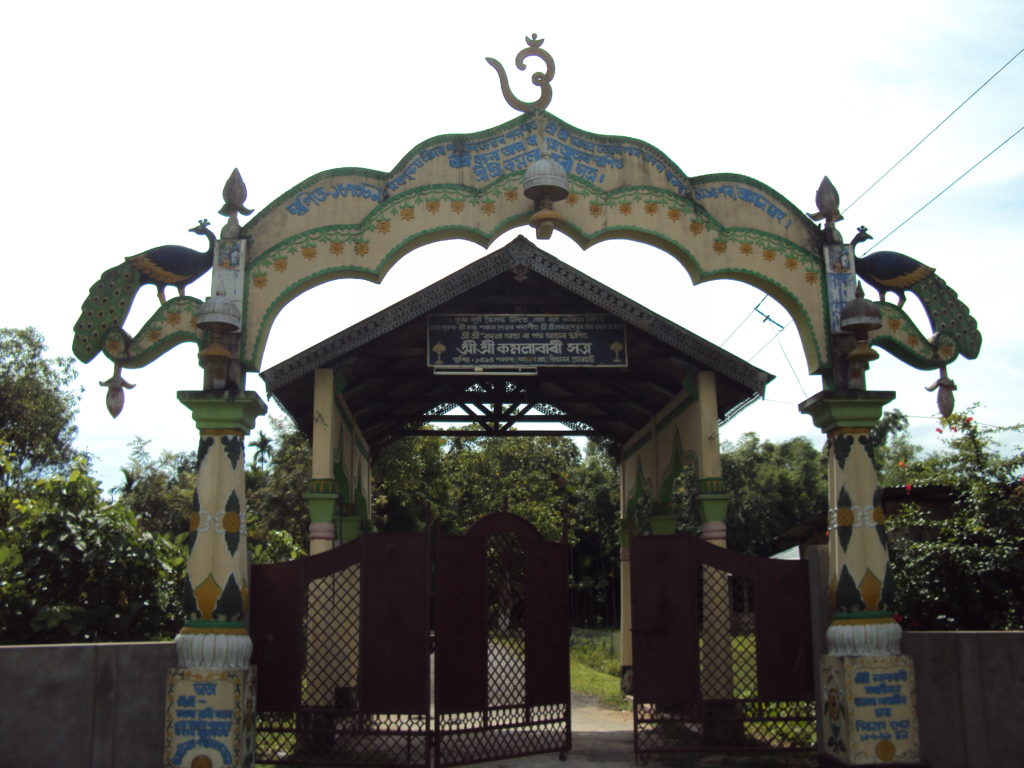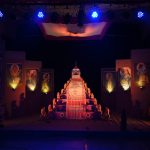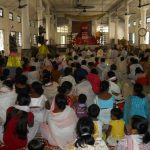The Thâns and Sattras have played a crucial role in shaping the Assamese society. This institution created by Srimanta Sankaradeva in the medieval era helped Assam and the Assamese in getting modernised, in getting rid of medieval evils. One of these activities carried out by the Thâns and Sattras included the crucial task of spreading education among the people at large. Some people tend to say that the Sattra institution was not created by Srimanta Sankaradeva. But the fact is that all major components of Sattra were included in the Bardowa Thân founded by the saint in 1509. The main component, Kirtanghar was set up there way back in 1468 itself. Later the nomenclature was changed from Thân to Sattra; moreover some more minor components like Rângali-ghar etc came to be added. But the major components of Sattras are very much those of the Thâns. So the achievements of the Sattras are ultimately attributable to Srimanta Sankaradeva.
Spreading education among the people in the medieval Assam was not a small task. It was a period when entry in the residential schools known as Tol were restricted to the pupils of so called high castes only. Education was not universal in those times. People at large remained in the abyss of ignorance. It took a reformer of Srimanta Sankaradeva’s calibre to redeem them. He did it very tactfully without taking on the prevailing education system and their educationists. He devised a new supplementary model to educate people. This model was that of mass communication and multi-media. His songs and plays contained the very same materials which were included in the syllabus of Tol courses. As Srimanta Sankaradeva’s songs and Ankiyâ plays reached all people, everyone could learn what was taught in the Tols. The Kirtanghar was designed in such a manner that songs and Ankiyâ plays rendered there could be enjoyed by all people. There was no closed wall in Kirtanghar. This was a good model of mass communication. Srimanta Sankaradeva communicated with the masses with ease. He conveyed his teachings directly to the masses from the floor of Kirtanghar. The more his songs and Ankiyâ plays were performed, the more the common people were educated by the educational norms of those days. Clearly the saint was carrying out a radical educational reform; in fact he was implementing a new system of non-formal education.
Another notable feature of the non-formal education system innovated by Srimanta Sankaradeva was that he used to teach ethical and other positive values to his followers. In fact all his writings are about different positive values. Apart from the words and verse on monotheism, we find nothing but advices and advices alone all through his voluminous writings. He asked people to give up demonic nature. Interestingly the modern education system also follows a similar approach. University Grants Commission of India has of late given emphasis on incorporating value education in the curriculum of higher education as it is never sufficient to learn knowledge and skill alone. If a student does not learn ethics and other positive values he/she may become a machine or even unsocial element. A degree does not necessarily means that the holder is a wise person. Srimanta Sankaradeva wanted people to become wise. So he harped on positive values in his writings.
Srimanta Sankaradeva used to teach his followers in his art forms like dance and music, in addition to the ethical and religious teachings. When the play Chihna-Yâtrâ was planned, he trained the drummers and danceuses himself. He trained the Gâyans-Bâyans himself. He trained the Sutradhârs himself. Over time it became a regular practice to teach the artists as Srimanta Sankaradeva continued with his cultural programmes. Thus the Thâns set up by the saint had cultural training centres. These were integral components of the Thâns though there was no nomenclature as cultural training centre or some thing like that. Actually the functions of the devotees overlapped in the Thân. A devotee performed all types of works : praying and offering services in the Kirtanghar, copying manuscripts, teaching or learning dance and music, preparing handicraft items, carrying out agricultural farming etc. This was the pattern in those days.
Agricultural farming was an integral part of Thâns and Sattras. It continues to be so. Srimanta Sankaradeva did not believe in ascetism. He preached devotion through an active life. He was a unique religious preceptor, who did not live on others. He was not a parasite; he eked out his living himself. Naturally he taught others too to live a practical life. Every devotee had to engage in works to eke out his living. It continues to be so in the Thâns and Sattras. The model of Thâns and Sattras is that of self-sustained living. The modern education also thrives for that and considers it as an ideal situation, which is very hard to achieve. Sri Aurobindo also tried it in Auroville. But Srimanta Sankaradeva achieved it way back in 15th century.
All these took place in Bardowa Thân for the first time. Later when other Thâns were set up, such educational activities were necessarily pursued. Everywhere the saint went, he got his Ankiyâ plays enacted. So there must have been a continuous process of training his disciples in the performing art forms he created. These included dance, music, painting, sculpture, instruments etc. For example an illustrated Bhâgavata was prepared at Dhuwahata under the supervision of the saint. In later times the newly set up Sattras also carried on with the tradition of imparting training. It became a norm to have educational facilities in every Thân or Sattra. To this day the Thâns and Sattras therefore have facilities for imparting education to the devotees in the traditions bequeathed by Srimanta Sankaradeva. These include the art of writing scriptures, making sculptures, performing dances and plays etc.
Srimanta Sankaradeva innovated a complete system of knowledge management as is done in modern days by the schools, colleges and universities. These modern institutions have well-developed educational management system, which is supervised by numerous experts equipped with specialisation. Similarly the young devotees are also put in the care of experts in the Thâns and Sattras. Just as there is gradual evolution of the students from schools to colleges and then to universities, the devotees in the Thâns and Sattras too undergo gradual evolution. For instance an instrumentalist first becomes a Bayan and then Barbayan. In the celibate Sattras, young kids are brought from the willing parents and then trained in the Sankari schools of dance, music, painting, sculpture, instruments etc over the years. These training of performing art actually continue along with literary training. The devotees are taught to read and write too as they have to read the scriptures and copy them as and when need arise. In fact Srimanta Sankaradeva got his eldest son Ramananda trained in the art of writing manuscripts. Madhavadeva also was an expert in this art. Both of them were expert accountants too.
The devotees stay in separate quarters called Bahâ in the Thâns and Sattras. Young kids are kept under the care and protection of a senior devotee known as Burhâ-Bhakat. It is his duty to train the young Bhakats. Every Bahâ is like a family home with the Burhâ-Bhakat as the head of the family. It is just like a modern residential school. The residential schools, especially those taking care of orphans follow this mode of accommodation as well as teaching. So Srimanta Sankaradeva was quite futuristic in evolving the Bahâ system in the Thâns and Sattras. Over time these young kids themselves are elevated to the status of Burhâ-Bhakat when they master all skills and traditions. This management system is unique for the celibate Sattras.
Srimanta Sankaradeva himself was an institution. Whatever he did was merely picked up by the Thâns and Sattras as his legacy and turned into tradition over time. So we have to analyse Srimanta Sankaradeva’s personal works too in any analysis of the Thâns and Sattras. The activities of the Thâns and Sattras are nothing but continuation of Srimanta Sankaradeva’s religious, academic and artistic agenda. For instance he initiated research works in medieval times itself. His Sanskrit book Bhakti-Ratnâkara is nothing but a research-based treatise on the philosophy of devotion. The preparation of this book is a proof of Srimanta Sankaradeva’s engagement in research works. Similarly he engaged in textual criticism too. The Ramâyana originally translated by Madhav Kandali and edited by Srimanta Sankaradeva is an example of that. All these are integral parts of higher education. That Srimanta Sankaradeva carried out these works was a proof that he wanted others too to engage in such works.
Srimanta Sankaradeva also engaged in innovative projects like utilitarian research projects carried out in the modern institutions of higher education. For instance he worked on the area of language and developed a liguâ-frâncâ for the entire Northern India with his Brajâwali. This form of language evolved by him from the Assamese dialect prevalent in the lower Assam in those days bound the people of Brahmaputra valley with the people of Ganga valley. It bridged these two regions effectively. Even now the Bargeets and Ankiyâ plays composed by Srimanta Sankaradeva are easily understood all over Ganga valley. This would not have been possible without deep analytical work by the saint. Thus the education system evolved by Srimanta Sankaradeva was a nice system, which had practical social utility.




